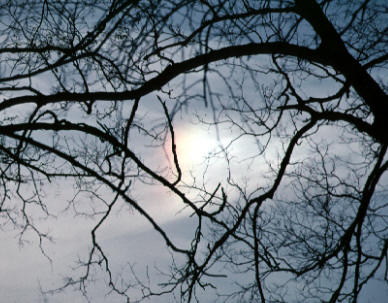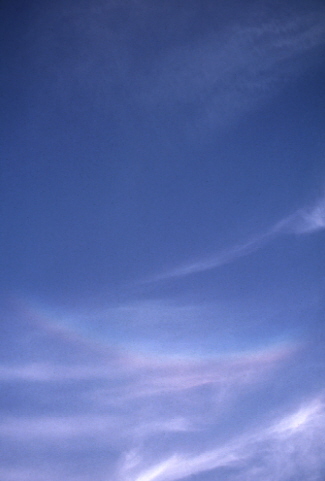|
The Most Beautiful Arc
Last Saturday, December 1st, we were returning to the house after planting some trees. Looking up at the sun we saw parhelia, or "mock suns," on either side of the sun. Also called "sun dogs," these colorful patches of light are caused by sunlight refracting through ice crystals in our atmosphere. Many times these ice crystals are found in the high altitude cirrus or cirrostratus clouds preceding a warm front. The mock suns appear at the same altitude above the horizon as the sun and about 22 degrees on each side. Like this mock sun we photographed from our farm, they are usually red on the side towards the sun, then yellow, then bluish white. To get an idea of how far to look from the sun to see mock suns, extend your arm and spread your fingers as wide as you can. The distance between the tip of your little finger and the tip of your thumb is about 20 degrees. Sometimes mock suns appear as bright patches in or slightly outside of a complete 22 degree halo around the sun. This common halo is caused by sunlight refracted through ice crystals with a hexagonal cross section and can be seen around the moon on some nights. If you see mock suns or the 22 degree halo around the sun always look directly overhead to the zenith. You may be rewarded with the most beautiful of the halo phenomena, the circumzenithal arc. As their name
suggests, these colorful arcs form around the zenith and span about 1/3 A good reference on halo phenomena which includes descriptions of rarer events like the 46 degree halo and the parhelic arc is M. G. J. Minnaert's, Light and Color in the Outdoors.
|

 of a
circle on the side towards the sun. They may be overlooked sometimes
because people rarely look directly overhead. Saturday we saw just such an
arc. It's hard to describe how beautiful these arcs are. They have
an ethereal quality, the colors intensifying and fading as the crystal laden
clouds drift slowly overhead. The arcs we have seen have occurred when the
sun was less than 30 degrees above the western horizon. We photographed
the arc shown on the right from our front yard in April, 1994.
of a
circle on the side towards the sun. They may be overlooked sometimes
because people rarely look directly overhead. Saturday we saw just such an
arc. It's hard to describe how beautiful these arcs are. They have
an ethereal quality, the colors intensifying and fading as the crystal laden
clouds drift slowly overhead. The arcs we have seen have occurred when the
sun was less than 30 degrees above the western horizon. We photographed
the arc shown on the right from our front yard in April, 1994.